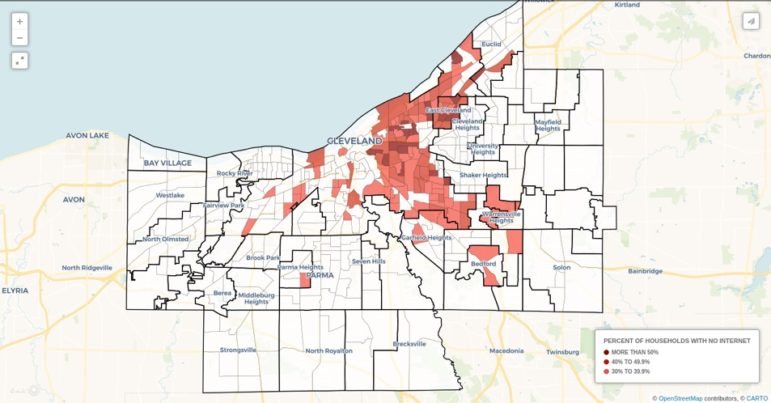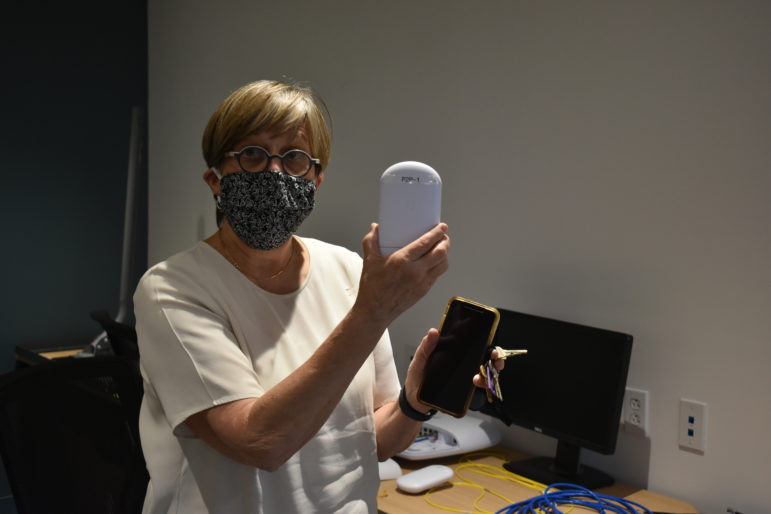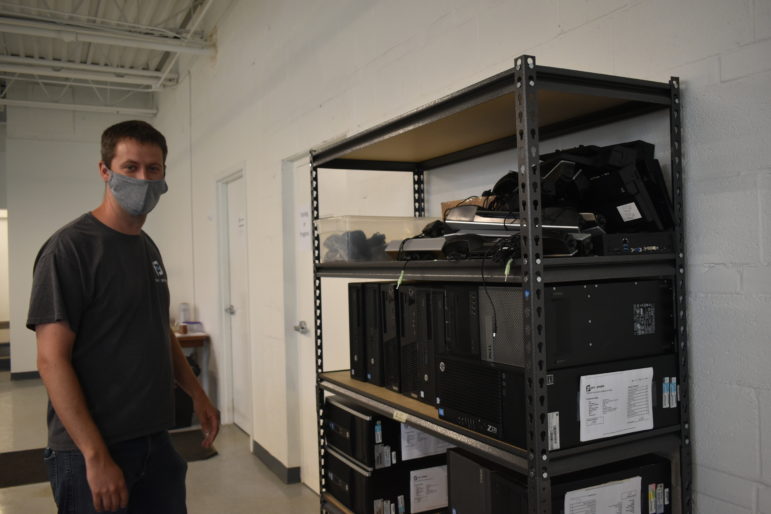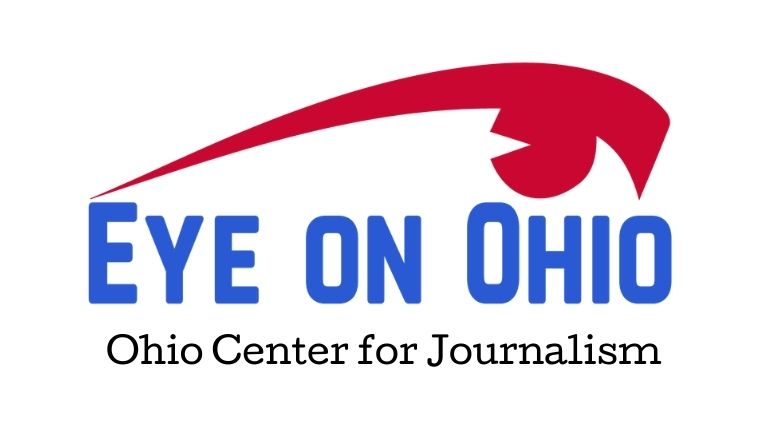This article provided by Eye on Ohio, the nonprofit, nonpartisan Ohio Center for Journalism. Please join our free mailing list as this helps us provide more public service reporting.
When districts switched to remote learning in the spring, the COVID-19 pandemic revealed a glaring divide: for example two-thirds of students in Cleveland Metropolitan School District didn’t have access to a device, and 40 percent of families didn’t have Internet access at home, according to a survey of parents conducted by CMSD .
With Cleveland Metropolitan School District soon returning to school in a remote-only format, the District is currently in a mad dash to prepare students, teachers and families for their first week of school with the COVID-19 pandemic still looming large.
The District has its work cut out for it. By some estimates, Cleveland is one of the worst-connected large cities in the country — and school begins as early as next week for some students.
To combat that, the district ordered about 27,000 laptops and tablets along with approximately 13,500 WiFi hotspots. The district has 40,000 students enrolled.

The measures come at significant expense. The district paid about $11 million for the devices and $3 million for the hotspots with one year worth of data, funded through a mix of school funds, federal CARES Act money and grants, said a CMSD spokesperson.
By the time the district’s remote-only classes begin this month, CMSD CEO Eric Gordon said the district will be close to a “one-to-one environment.”
It’s an immediate solution, but not a perfect one; teachers and student families need to be trained on using the technology, and once these families no longer have a CMSD student, they’ll need to give the equipment back.
School districts across the country are racing to achieve similar results as school reopens for the fall. Chicago Public Schools, for example, recently announced a $50 million program to bring free Internet access to 100,000 CPS students over the next four years (funded by various philanthropists, including Michelle and Barack Obama.)
Meanwhile, in Greater Cleveland, Cuyahoga County and the Cleveland Foundation recently announced a $4 million program, in partnership with T-Mobile, to provide 10,000 computers and 7,500 WiFi hotspots to student families.
Catherine Tkachyk, chief innovation officer for Cuyahoga County, said the hotspots and devices are being rolled out to families in school districts across the Greater Cleveland area currently, through distribution events coordinated between the nonprofit PCs for People and the school districts themselves.

Challenges facing school districts
Gordon with CMSD said it’s important to keep in mind that Cleveland’s issues with Internet access are not limited to the realm of K-12 education.
“When we shut down in Ohio, we told people, ‘go home, stay at home, apply for unemployment online, apply for jobs online, go to school online, go to your doctor online,’” Gordon said. “We need to broaden this conversation…. This is not (just) a school problem, this is a problem of the Internet not being a public utility in this country.”
If the Internet were treated like a utility like water or electricity – funded by taxes and protected by further regulations – there wouldn’t be such a problem with a lack of access, Gordon said.
Access to free Internet would be a game changer, said Marsha Howard, 71. She’s the sole caregiver for her grandson, who is an incoming fourth-grader at a CMSD school. She said she was not sure how well her grandson will do with remote-only learning for an extended period of time, especially considering the fact that he has a IEP (Individualized Education Plan) because of his learning retention issues. Plus, the laptop she and her grandson received from the district last spring was old and didn’t have the functionality to accomplish some of the tasks teachers asked them to do, she said.
“I don’t really see him doing very well without the help that the IEP is supposed to give him,” Howard said.
She noted that her grandson was meeting with a special education instructor a few times a week, which will now need to be done remotely.
“There are some kids that are just really really into computers and the internet and whatever, [but] he’s a more hands-on… type of person,” Howard said. “He likes to put things together, likes to figure things out with his hands.”
Gordon, CEO of the Cleveland schools, said that his district provided 1,300 cameras to its intervention specialists to allow them to work remotely with children with IEPs, invested in tele-therapy systems, and is giving specific training to teachers to further the goal of being able to help students with IEPS remotely. He also said there’s a help desk accessible over the phone or in-person to help parents with technological problems.
Howard also said that she was never offered a WiFi hotspot from the district, despite her lack of income. Gordon said that was likely because families who already had Internet access weren’t offered hotspots, in order to triage those with the greatest need. (Howard is paying for Internet already.)
“We have a week planned for family-student parent-teacher conferences where we’ll be creating a care plan for each family, assessing their technology needs both for devices and access to high-speed Internet,” Gordon said.

A new model to bridge the digital divide
Bearing these challenges in mind, CMSD has become an “anchor” for an innovative project that could provide a long-term solution for Cleveland’s digital divide.
Announced earlier this year, CMSD will pay Cleveland nonprofit DigitalC to extend high-speed Internet services to thousands of CMSD families, targeting parts of the city where the digital divide is most severe.
The first goal, according to DigitalC CEO Dorothy Baunach, is to bring Internet services through an innovative fixed-wireless system to 1,000 CMSD households before the school year starts (which will be paid for by CMSD while families have CMSD students in the household.)
DigitalC spokesperson Jim Kenny said that as of last week, only 252 CMSD student households out of 1,000 were signed up for Internet services through EmpowerCLE. What’s more, DigitalC and CMSD are still working on launching a fundraising campaign to build out the full network, an initiative that will cost at least $36 million.
“To get to those 16,000 households, the capacity of the full network will actually be around 27,000 households,” Baunach explained, noting that DigitalC will be able to serve non-student homes as well.
“When the technology is headed into the neighborhood it doesn’t know who lives in the houses, it just knows if you can reach it or not,” she said.
Angela Siefer is executive director with the National Digital Inclusion Alliance (NDIA), a nonprofit advocating for broadband access based in Columbus. She said the main digital barrier that families face in Ohio is the relative expense of Internet services, rather than a lack of infrastructure built to access those services.
“Poverty tracks closely with broadband adoption,” she said.
County has its own short-term fix
While DigitalC is scrambling to expand its network and get families signed up for services, the nonprofit PCs for People, with a branch in Cleveland, is similarly hustling to get devices out to local K-12 families.
PCs for People is the lead partner in the County’s effort to provide 10,000 laptops and other devices to non-CMSD schools.
Bryan Mauk, executive director for PCs for People, said that it’s a tall order to get that many devices out to students before school starts, especially with plenty of other school systems across the country seeking as many devices as possible. Before the pandemic, the nonprofit would distribute 100-200 computers a month at low cost, $30 for a desktop and $50 for a laptop; when schools pivoted to online-only last spring, PCs for People started pushing out about 1,000 to 2,000 computers a month. Now, it’s an all-out scramble to get as many computers out as possible, Mauk said. The nonprofit is currently accepting donations of old computers and laptops, especially from the business community. Anyone interested can call 216-600-0014 or email cleveland@pcsforpeople.org.
Mauk said that while the county’s initiative will cover two of the most immediate needs – providing devices and hotspots – there’s a key third need.
“So, there’s the device and the connection, but then the third part is the ongoing support,” Mauk said. “The other thing that we offer is all of our stuff has got a one-year warranty on it, that’s three free repairs. We also offer digital literacy classes each week here.”
Ashbury Senior Community Computer Center, Cuyahoga Metropolitan Housing Authority and the libraries also have their own digital literacy classes, Mauk added.
Catherine Tkachyk, chief innovation and performance officer for Cuyahoga County, said she knows that the digital divide will persist even despite the current effort.
“These two years give us some runway to try to solve that problem that’s community-wide,” she said. “A long-term, sustainable solution, that’s really what we want to do. The digital divide didn’t show up with the pandemic and it’ll be there after the pandemic if we don’t make an effort as a community to change it.”
Chicago tries its own hand; what will the future hold?
Chicago Public Schools (CPS) is in the midst of a similar push to get students connected to free Internet services as fast as possible before school gets under way in what is likely the largest such effort currently under way in the country. According to a news release, more than 100,000 students at CPS (out of 356,000 students) don’t have access to high-speed Internet; the “Chicago Connected” program, announced last month, aims to change that.
Phillip DiBartolo, chief information officer for CPS, said the program involves the school district negotiating cheap monthly rates for Internet services from traditional broadband providers for student families, while providing wireless hotspots for students in transitory living situations and those that don’t have access to traditional wired services. Those services will be provided free for the next four years.
Hal Woods, with the nonprofit Kids First Chicago, said the program is unique because it has 35 community partners (including Kids First) to help the school district reach families, to do digital literacy education for adults in those families, and to provide workforce training and other opportunities to those adults.
“This is not just about us providing Internet connectivity. It’s also very much geared to ensure adults in those households are trained on how to use the Internet effectively,” Woods said.
Daniel Anello, CEO of Kids First Chicago, said so far, it’s likely that only a few thousand families have been connected through that effort, but that’s mostly before most community partners have started outreach.
Siefer, with the NDIA who is familiar with Chicago’s program, and said one important takeaway from Chicago Connected is the use of trusted community partners – organizations that people already know – to let people know that free Internet service is available.
“If you’re told that, ‘look, there’s this free Internet, it’s for you’… a lot of folks are going to be like, ‘this is a scam,’” Siefer explained.
Back in Cleveland, DigitalC is using former CMSD students to perform some of that outreach work as “brand ambassadors,” trying to get the word out to families about DigitalC’s Internet services, Baunach said. They’ll be going door-to-door and trying to engage with CMSD families via social media, as well.
Baunach said it’s unfortunate that it’s taken a pandemic to get people energized around the topic of expanding broadband access. Still, she’s hopeful for the future.
“Everybody now recognizes this problem; we don’t have to tell people the ‘why’ anymore, we just have to say, ‘we think we know how,’” she said. “And we pretty much believe we’re the ones on the ground and prepared to do this.”
Conor Morris is a corps member with Report for America. You can find him on Twitter at @condormorris, or email him at cmorris@advance-ohio.com. This story is sponsored by the Northeast Ohio Solutions Journalism Collaborative, which is composed of 16-plus Greater Cleveland news outlets including Eye on Ohio, which covers the whole state.

